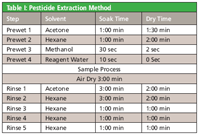An Alternative Way to Extract Organochlorine Pesticides from Water Using Automated Solid Phase Extraction
Pesticide pollution is a subject of global concern, and although many countries have now banned the use of organochlorine pesticides, they linger in the environment and can contaminate water sources.
Michael Ebitson, Horizon Technology, Inc.
Pesticide pollution is a subject of global concern, and although many countries have now banned the use of organochlorine pesticides, they linger in the environment and can contaminate water sources. Pesticides are toxic to animals and humans, so methods which accurately and easily extract and analyze them are essential. Organochlorine pesticide exposure can cause illnesses including disruption of the immune, reproductive, and endocrine systems, along with causing neurobehavioral disorders and cancer.
By using solid phase extraction (SPE), acetone and hexane were used as the extraction solvents for the determination of organochlorine pesticides in aqueous samples. This was accomplished by optimizing an SPE method based on the Horizon Technology SPE-DEX 4790 Automated Extractor system using a 47 mm Atlantic HLB-M extraction disk.
The pesticides analyzed in this study were part of a standard mix consisting of alpha-BHC, gamma-BHC (Lindane), beta-BHC, delta-BHC, heptachlor, aldrin, heptachlor epoxide, gamma-chlordane, alpha chlordane, 4,4'-DDE, endosulfan I, dieldrin, endrin, 4,4'-DDD, endosulfan II, 4,4'-DDT, endrin aldehyde, methoxychlor, endosulfan sulfate, and endrin ketone. Tetrachloro-mxylene (TCMX) and decachlorobiphenyl (DCB) were used as the extraction surrogates.
Materials and Methods
Horizon Technology
-SPE-DEX® 4790 Automated Extractor System
-Envision® Platform
-Atlantic™ HLB-M 47 mm disks
-DryVap® Concentrator System
-DryDisk® Separation Membranes
Sample Preparation
1) Adjust a 1 L aqueous sample to a pH of 2 with HCL. Cap the bottle and mix.
2) Spike the sample with pesticide standard and surrogates (varying concentrations were used: 0.5 µg/L–1.25 µg/L).
3) Place the sealed sample bottle on the SPE-DEX 4790 Extractor system and place the Atlantic HLB-M disk in the disk holder.
4) Run the SPE-DEX 4790 using the pesticide method in Table I.
5) After the extraction is completed collect the extract (the final volume will be 25 mL).
6) Clean the extract using florisil.
7) Dry then concentrate the extract to a final volume of 5.0 mL.
8) Analyze by dual GC/ECD.

Table 1
Results
With the sample extracted in acetone and hexane instead of DCM, the solvent exchange step has been eliminated. The results ranged from 81–100% on the primary column and 76–88% on the secondary column. When using automated SPE the extraction process duration was about 30 min per sample. The extractor can process a sample up to 150 mL/min. Drying and concentrating a 25 mL extract of hexane to a final volume of 5 mL took approximately 10 min with the DryVap. Cleanup with florisil took an additional 10 min. With the 10 min sample run times on the GC/ECD, samples were extracted, dried, concentrated, cleaned, and analyzed within 1 h with excellent recoveries.
Conclusions
The sample preparation step is an essential element in this analytical procedure, as such, the advancement of an automated disk extraction enables less solvent use, an elimination of the solvent exchange step, reduced glassware use, emulsion elimination, and faster extraction times with highly particulate or sediment laden samples. This in turn produces consistent and reproducible
results.
Horizon Technology, Inc.
45 Northwestern Drive, Salem, NH 03079
tel. (603) 893-3663 or (800) 997-2997, fax (603) 893-4994
Website: www.horizontechinc.com

Separation of Ultra-Short and Long Chain PFAS Compounds Using a Positive Charge Surface Column
December 11th 2024A separation of ultra-short and long chain PFAS (C1-C18) is performed on a HALO®PCS Phenyl-Hexyl column along with a HALO®PFAS Delay column which demonstrates excellent retention for both hydrophilic and hydrophobic analytes.















